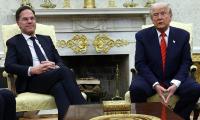Prime Minister Imran Khan did a grand job in official meetings in DC this past week. Our PM’s first meeting with an unpredictable and egotistical US president, who had blamed Pakistan for deceit in relation to Afghanistan not too long ago, could have gone anywhere. But it didn’t. IK stayed on message. He didn’t get entangled with any of the thorny Trumpisms. IK’s claims about press freedom in Pakistan aside, he came across as thoughtful, composed and genuine. And from the word go it was clear that US is ready to do business with Pakistan once again.
The US is unabashed that way. When ready for a transaction, it makes no bones about it. It lays out the red carpet, flatters visiting guests, offers them favourable media and think-tank exposure and sends them off feeling all warm and fuzzy. But if the transaction goes south, the bonhomie can disappear as unexpectedly as it appears. And there isn’t anything unique or evil about how the US conducts itself. It is interests and not emotion that drive inter-state relations. So what does the US want us to do and what is in it for us?
The PM-army chief US visit was about Afghanistan. Trump threw in the idea of mediating the Kashmir dispute and recognizing its centrality in the context of peace in South Asia for good measure to make Pakistan feel giddy. But let’s not get too excited about it. There will be no US mediation on Kashmir unless India wants it. The real significance of Trump’s Kashmir comment is that words spoken by a US president inform the larger narrative. We didn’t hear #DoMore this time. Pakistan was again being embraced as a potential ally in South Asia.
Kashmir, quadrupling of trade, reinstatement of assistance etc are the carrots meant to incentivize Pakistan to deliver Afghanistan. Pakistan is out of the doghouse not because Pakistan did what the US wanted it to do in the past. But because the Trump Administration’s position on Afghanistan has changed and it needs the Pakistan Army to deliver the honourable exit President Trump seeks prior to his re-election. Pak-US interests might be aligned again because what Pakistan was offering all along is now the most viable option for President Trump.
At some point during its expensive and unending Afghanistan excursion, the US realized that the constitutional structure and regime propped up by the US-led international community might not persevere. The Taliban remain a force to be reckoned with and will need to be given a seat at the table. The size of the pie and the terms on which it was to be offered was thus the sticking point. The US wanted Pakistan to help squeeze the Taliban and weaken them to a point where they would be willing to sign the dotted line.
Pakistan kept saying that it didn’t have the kind of leverage to be able to deliver the Taliban as desired by the US. Its own assessment was that post US withdrawal the government in Kabul would be unable to fend off attacks by the Taliban and others. And if ultimately the Taliban were going to remain a key force in the power structure controlling Afghanistan, it was against Pakistan’s interest to create an enemy out of them when they already begrudge Pakistan for its U-turn post-9/11, and also control provinces bordering Pakistan and will continue to do so.
Pakistan continued to argue that the Taliban might hold extremist and retrograde views but don’t nurture the ambition to export terror to the West or expand control beyond Afghan borders. That the Taliban on their own aren’t a problem for the world and what is important is to ensure that ideological extremist groups like Isis don’t acquire a foothold in Afghanistan and use it as a sanctuary to export terror to the rest of the world. The Trump Administration seems to have come around, notwithstanding past US rhetoric about democratizing Afghanistan etc.
So here we are. President Trump wishes to withdraw troops and declare Mission Afghanistan successfully closed before Election 2020. The US understands that to consummate the transaction in the given timeline it must partner with the state of Pakistan, which boasts the only security force in the region with the kinetic ability and intelligence network to help broker an intra-Afghan deal (with the Taliban as a part of it) and then act as a stabilizer post US withdrawal. So far so good. But in deal making, the devil is in the detail and that is where things could get sticky.
What does this mean for Pakistan? Once we are done with high-fives over how our take on Afghanistan has won, we must focus on where things could go terribly wrong. We seem to be at the cusp of a return to the 1990s. And we know how that turned out. It is good to not have the US breathing down our necks or worrying about India growing its influence in Afghanistan and planning nutcracker manoeuvres. But beyond US-withdrawal and Taliban accommodation in Kabul’s power structure, there is much for Pakistan to think through.
We know that the internecine intra-Afghan conflict is legendary. We might be able to get the Taliban in a room with other stakeholders in Afghanistan, but we don’t have the wherewithal to enforce an intra-Afghan compact. Many in Afghanistan see Pakistan as an intervening force. US failure to cut the Taliban to size post-9/11 doesn’t make the 90s look rosy. Mission US-exit mustn’t entail growth of our footprint across our western border. Playing kingmaker in Afghanistan didn’t serve us well in the past. Let’s remember that amid our exuberance.
US withdrawal also must not mean disappearance of US-led fiscal contribution that keeps Afghanistan afloat. If there is no effective plan for Afghanistan’s reconstruction, the consequences of a continuing civil war might not reach the US but will most certainly reach Pakistan. Further, our army has been fighting a hard and exhausting war against local terror groups. That fight isn’t over yet. And, while the Taliban might have no plans to conquer the West, their worldview and proximity to Pakistan does inspire their extremist Pakistani cousins.
US Election 2020 and President Trump’s desire to declare victory by extricating the US from ‘costly foreign wars’ has opened up a narrow window of opportunity for Pakistan to reset relations with the US. Temporary US interest in military-to-military engagement as opposed to a strategic or lasting basis for re-engagement is the driver of this reset. The last two times we forged a military-driven alliance with the US (in the 80s and post-9/11) under dictators, we did lasting damage to our security interests as well as fundamental rights and civil liberties in Pakistan.
For the architects of our national security policy, this is the time to choose. They can either view this limited opportunity as vindication of the approach that projects non-state actors and militant groups as assets and levers of state power. Or they can greet this is a chance to undertake course correction, to take the fight against extinguishment of non-state actors to its logical conclusion, put the FATF behind us and use this window to showcase Pakistan’s potential as a peacemaker in South Asia. It will be a real tragedy if we refuse to learn even from our own mistakes.
And for proponents of fundamental rights and civil liberties, the challenge could not be more acute. On the one hand, the state’s hard power is more relevant than ever. The world continues to engage with Pakistan due to what this power can do or obstruct and not because of the industry of its populace or its potential as a trading partner or consumer market. And on the other, the world is witnessing expansion of populism and authoritarianism and contraction of civil liberties and fundamental rights.
In the backdrop of our partnership with Trump’s America, we can expect to see authoritarianism here claiming even more space and leverage to curb liberties for what we will be told is national interest. So gear up folks and get indigenous. This is going to be a long and hard one.
The writer is a lawyer based in Islamabad.
Email: sattar@post.harvard.edu
People of that time believed that an eclipse was a symbol of displeasure of gods
Vertically speaking, dominance of domestic debt in Pakistan’s debt portfolio is haunting
Loss of biodiversity is stark reminder that urban mismanagement is not just infrastructural failure but ecological...
Strong public warning systems can also help ensure quick evacuations in places prone to fires
PPPs in Pakistan's WASH sector face significant regulatory and policy challenges that hinder their effectiveness
Instead, it would have powerful chairman with three-year term, appointed at prime minister’s discretion







